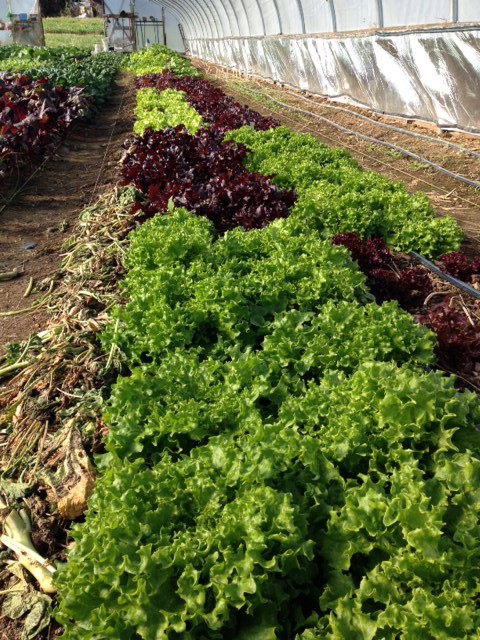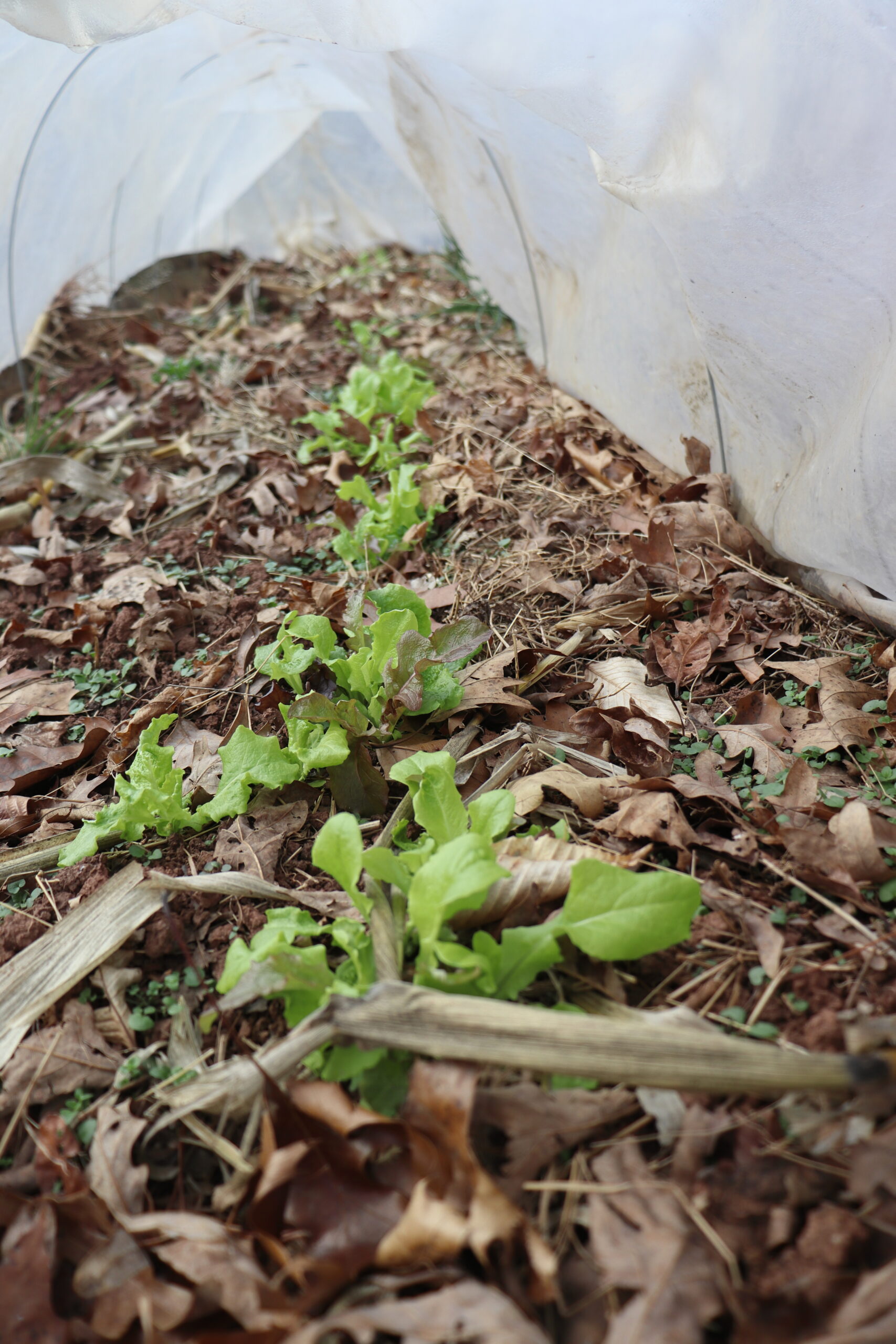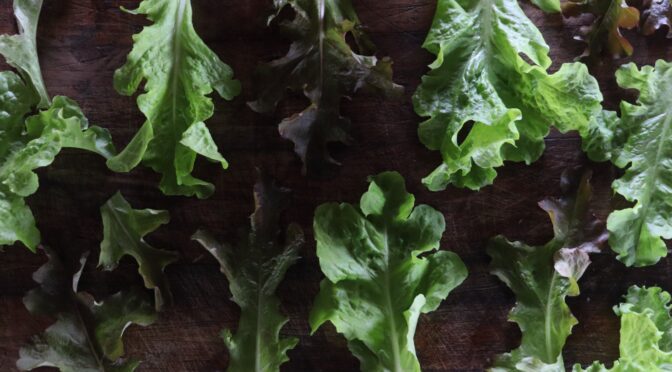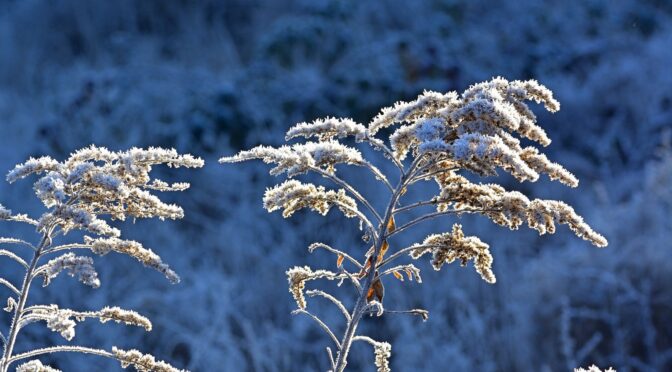In much of the Southeast, it’s challenging to get good lettuce production during the summer. We get a few cool weeks in the early spring before the heat sets in, and our lettuce bolts and turns bitter. In years like this, where hot, dry weather lingers, fall production can be challenging, too. Thankfully, winter lettuce production is surprisingly easy.
While lettuce isn’t technically as cold-tolerant as some of the tougher greens, you can still produce good lettuce with a bit of protection and proper care.

Season Extension for Lettuce
In some areas of the Deep South, you get away with growing lettuce in the field with no additional protection. However, lettuce isn’t incredibly frost tolerant, so in most places, you need to provide some additional frost protection.
Unheated greenhouses, cold frames, and high tunnels offer the most protection while still providing plenty of sunlight. These are ideal for mountainous areas where serious cold protection is needed.
That said, you can usually get away with more affordable and accessible options. Row cover and low tunnels made with clear plastic and wire hoops can give you a cheap, easy-to-install method of season extension. Note that low tunnels and row cover can reduce airflow, potentially encouraging pest and disease issues, so it’s important to stay vigilant and open them when possible.
In very cold temperatures, you can combine the two methods. You can use row cover to provide an extra buffer for lettuce growing high tunnels and greenhouses.

Lettuce Soil Requirements
Lettuce is generally considered an easy crop, but like any crop, it will perform better with optimum soil conditions, particularly during the winter. It thrives in well-drained soil with a pH between 6.0 and 6.5.
It often surprises new growers, but lettuce is a heavy feeder because it grows so quickly. It benefits from soil rich in minerals and organic matter, so amending your soil with compost before planting is a good idea. You also want to consider this when planning your cover crops and crop rotation.
Especially if you have struggled with lettuce in the past, a soil test is a great tool that will allow you to amend your soil appropriately.
Lettuce Seeding
In the Southeast, we can get away with seeding lettuce pretty late into the fall. You can continue direct sowing as long as your soil temperature needs to be above 32°F. However, that doesn’t mean you will get quick growth.
Cold temperatures, cloudy days, rain, snow, and limited daylight can all affect lettuce growth. It may feel like your lettuce isn’t growing at all. It’s not unusual for lettuce to take up to an additional 30 days or even longer to mature over the winter. Getting seeds in the ground in the fall is helpful for winter harvests. Additionally, you’ll begin seeing faster growth as the days grow longer in February and spring.
When seeding your winter lettuce, sow seeds about 1/4 inch deep. The spacing you need for for rows of lettuce depends on what size you intend to harvest your lettuce at.
Generally, when harvesting lettuce during the winter, we harvest it as baby greens. This means we get to enjoy a harvest a bit earlier. It also protects the lettuce. Smaller lettuce is much more frost and cold-tolerant than mature heads. For baby lettuce harvests, you can get away with 4-inch row spacing, but closer to 12 inches for mature heads is ideal.

You can also transplant lettuce. Transplanting is a great way to keep successions going, get seeds started faster, and fill in any gaps in your cold frame, hoop house, or other bed throughout the winter.
Winter Lettuce Care
Winter lettuce tends to be a bit more hands-off than spring lettuce, but that doesn’t mean there’s nothing to manage. Weed pressure is less in the winter, but you should remove any fall weeds as these can be harbors for pests and diseases.
You should also continue to water lettuce through the winter. As it grows more slowly, winter lettuce has lower moisture needs but still requires periodic watering to keep the soil moist in low tunnels, cold frames, greenhouses, and high tunnels.
It’s critical to keep water off the leaves when watering, as this can encourage disease and frost issues. Water lettuce at the base. Drip irrigation or soaker hoses are ideal.
You also want to keep your lettuce from overheating and offer good airflow whenever possible. On warm and sunny days, vent high tunnels, cold frames, greenhouses, and low tunnels whenever possible.
Despite the cooler temperatures, pests and disease can still play a role in winter lettuce production, partly because of the minimal airflow and moisture associated with season extension devices. Watch for pests like aphids, mites, and white flies, as well as fungal diseases like powdery mildew, dampening off, and bottom rot and bacterial diseases like soft rot.

Lettuce Varieties for Winter Production
When selecting lettuce for the winter garden, you may want to choose varieties different from what you would usually pick for gardening in the Southeast. Cold-hardiness and disease resistance are of the utmost importance during for winter production.
Here are a few of our favorites:
- Capitan Bibb (Butterhead) Lettuce
- Crawford Bibb (Butterhead) Lettuce
- Forellenschluss Romaine Lettuce
- Quan Yin Batavian Lettuce
- Red Salad Bowl Looseleaf Lettuce
- Rouge d’Hiver (Red winter) Romaine Lettuce
- Salad Bowl Looseleaf Lettuce
- Speckled Bibb (Butterhead) Lettuce
- Winter Density Buttercos Lettuce
Winter Lettuce Harvest
As mentioned above, harvesting your winter lettuce as baby greens is ideal. If possible, harvest lettuce when the leaves are dry and gently cut the leaves with scissors or a knife. Especially in cold weather, lettuce is easy to bruise.
You can store lettuce in the fridge, but for best results, we recommend harvesting just before you’re ready to eat.
You can grow lettuce all winter long in the Southeast using a few basic strategies. Keep growing this winter, and enjoy fresh, crisp salads!




